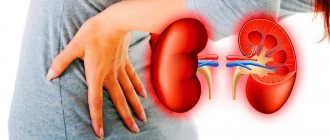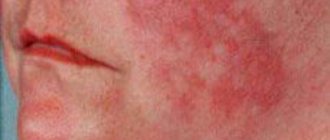Tuberculosis in children
Early period of primary tuberculosis infection
The initial phase of interaction between the pathogen and the macroorganism lasts from 6 to 12 months from the moment the child is infected with Mycobacterium tuberculosis. During this period, there is an asymptomatic stage (about 6-8 weeks) and a turn of tuberculin tests - the transition of the Mantoux reaction from negative to positive for the first time. A child with severe tuberculin reactions should be referred to a phthisiatrician and monitored by a specialist for a year. In the future, such children remain infected with Mycobacterium tuberculosis or, under unfavorable conditions, develop one or another local form of tuberculosis.
Tuberculosis intoxication in children and adolescents
It is an intermediate form between primary infection and the development of a local tuberculosis process, determined by x-ray and other methods. The clinical course of this form of tuberculosis in children is characterized by nonspecific manifestations: malaise, irritability, loss of appetite, headache, tachycardia, dyspepsia, arrest or weight loss, and a tendency to intercurrent diseases (ARVI, bronchitis).
A long-term causeless low-grade fever is typical, against the background of which temperature candles appear up to 38-39 ° C; There is increased sweating, especially during sleep. Tuberculosis intoxication is accompanied by a specific reaction of the lymph nodes - their multiple enlargement (micropolyadenia).
If signs of tuberculosis intoxication in children persist for more than 1 year, the condition is regarded as chronic.
Primary tuberculosis complex
This form of tuberculosis in children is characterized by a triad of symptoms: the development of a specific inflammatory reaction at the site of infection, lymphangitis and damage to regional lymph nodes. It develops when a combination of massiveness and high virulence of tuberculosis infection with a decrease in the immunobiological properties of the body. The primary tuberculosis complex can be localized in the lung tissue (95%), intestines, and less commonly in the skin, tonsils, nasal mucosa, and middle ear.
The disease can begin acutely or subacutely; masquerade as influenza, acute pneumonia, pleurisy, or be asymptomatic. Clinical manifestations include intoxication syndrome, low-grade fever, cough, shortness of breath. Changes in the primary lesion go through an infiltrative phase, a phase of resorption, compaction and calcification (formation of a Gohn's lesion).
Tuberculous bronchoadenitis
Bronchoadenitis or tuberculosis of the intrathoracic lymph nodes in children occurs with specific changes in the lymph nodes of the root of the lung and mediastinum. The frequency of this clinical form of tuberculosis in children reaches 75-80%.
In addition to low-grade fever and symptoms of intoxication, the child develops pain between the shoulder blades, whooping cough or bitonic cough, expiratory stridor, caused by compression of the enlarged intrathoracic lymph nodes of the trachea and bronchi. Upon examination, attention is drawn to the expansion of the subcutaneous venous network in the upper chest and back.
Complications of tuberculous bronchoadenitis in children may include endobronchitis, atelectasis or pulmonary emphysema. This clinical variant of tuberculosis in children requires differentiation from Beck's sarcoidosis, lymphogranulomatosis, lymphosarcoma, and nonspecific inflammatory adenopathy.
Tuberculosis in children (questions and answers)
What is tuberculosis?
Tuberculosis is a dangerous infectious disease that, without timely and proper treatment, can lead to loss of ability to work, disability, and death. Tuberculosis most often affects the lungs (pulmonary tuberculosis), but can also develop in other organs (tuberculosis of the lymph nodes, skin, eyes, bones and joints, etc.).
What causes tuberculosis?
Tuberculosis is caused by Mycobacterium tuberculosis. This is an unusually viable microorganism that retains its properties during drying, freezing, and after treatment with alcohol, acid and alkali.
How does infection occur?
In most cases, tuberculosis is transmitted by airborne droplets from a patient with an infectious form of pulmonary tuberculosis, i.e. secreting Mycobacterium tuberculosis. The main source of infection is the patient’s sputum, tiny droplets of which, infected with Mycobacterium tuberculosis, enter the air when he coughs, sneezes, spits, or talks. They penetrate with air into the lungs of healthy people and lead to infection (infection) with tuberculosis.
Children, like adults, become infected with tuberculosis by inhaling air containing Mycobacterium tuberculosis. Infants and young children most often become infected within the family or from close friends and neighbors. School-age children can also become infected in public places through contact with a patient with pulmonary tuberculosis.
Why do some people get tuberculosis and others not?
Most people who are infected never get TB because their immune system suppresses the infection. 5-10% of those infected get sick. Usually this is facilitated by other serious illnesses, HIV infection, living in cramped, damp and cold rooms, poor nutrition, hard work in poor conditions, severe stress, that is, everything that leads to a weakened immune system.
At what age do children most often develop tuberculosis?
Young children (under 3 years of age), especially in the first year of life, are very susceptible to tuberculosis. At this age, the body’s defenses have not yet been developed, because when Mycobacterium tuberculosis enters it, the disease develops very quickly.
The second period of reduced resistance to tuberculosis in children is the age from 10-11 to 14-16 years, when immunity decreases due to rapid growth and hormonal changes in the child’s body.
What contributes to the occurrence of tuberculosis in children:
- Intrafamily contact with a patient with a contagious form of tuberculosis.
- Past infections (measles, whooping cough, pneumonia, chicken pox).
- Smoking, drug use.
- Poor nutrition of the child (excess carbohydrates, lack of protein).
How to determine if a child is infected with tuberculosis?
This is done using immunodiagnostics of tuberculosis using the Mantoux test or recombinant tuberculosis allergen (Diaskintest).
How are children diagnosed with suspected tuberculosis?
Children are examined in the same way as adults: they are examined, while parents are asked about changes in the physical condition and behavior of the child, his complaints, a sputum test is done if the child produces it, a chest x-ray and other necessary studies.
Is there a vaccine against tuberculosis?
There is such a vaccine. This is the BCG-M vaccination. Although it does not completely eliminate the possibility of tuberculosis for a child, it must be done, as it protects children from fatal forms of the disease, such as tuberculin meningitis and miliary tuberculosis. All healthy newborns are vaccinated on the 3rd-5th day of life.
How to protect a child from tuberculosis?
Children get sick primarily through contact with adults with tuberculosis. Pay attention to your well-being and the health of those around you. A person who is coughing may be suffering from tuberculosis. Therefore, if your relative, co-worker or acquaintance who is in contact with your child coughs for a long time, insist that he see a doctor and limit his contacts with the child. Take an interest in the health of those people who will temporarily live in your family or often come to your home.
If there is a person with tuberculosis in the family, he should be isolated from children. Ventilate the room as often as possible and wet clean it 2-3 times a day. The patient should cover his nose and mouth with a handkerchief or napkin when coughing and sneezing; use a spittoon, which should be disinfected.
Take care to strengthen your child's immunity.
In order for a child to be able to resist any disease, he must eat regularly and nutritiously, follow a daily routine, be in the fresh air, and not overwork. Share on social media networks
CHEST PAIN WITH TUBERCULOSIS
Pain of varying intensity in the chest, under the ribs and behind the shoulder blades sometimes appears in the initial stages of the disease. As a rule, in the early stages there is discomfort or mild pain. As tuberculosis progresses, pain becomes more pronounced, especially when taking a deep breath.
Remember that you should consult a doctor at the first symptoms. This will save you valuable time and significantly increase your chance of a full recovery.
Clinic from scratch
Tuberculosis in children and adolescents is a global problem throughout the world. The situation in the fight against tuberculosis infection is worsening due to a decrease in children's resistance to infectious diseases, as well as frequent contacts of children with sick adults.
Tuberculosis is an insidious infection
Infection occurs from person to person through airborne droplets during talking, coughing and sneezing; through household items, food, through any things where the bacteria has settled. Tuberculosis is an infection that affects absolutely any segment of the population, people of different ages and genders. Children are at particular risk. Children can become infected with the bacteria on playgrounds, on public transport, in shops, as well as from a sick relative or friends. The insidiousness of this disease is that it does not manifest itself in any way for a very long time, and symptoms appear only with irreversible changes in the body.
The disease affects all human organs, but most often the bacterium settles in the bronchopulmonary system. The disease is caused by Mycobacterium tuberculosis, or Koch's bacillus, named after Robert Koch, who discovered the causative agent of tuberculosis in 1882. Mycobacterium tuberculosis is very active and resistant to the external environment; it lives for a long time in the soil and in dried saliva.
Infection with Koch's bacillus occurs in childhood. According to statistics, of all infected people, every tenth person can get sick. For most people who are infected, the immune system will suppress the disease, and therefore they will never develop tuberculosis.
Children at risk for tuberculosis:
- from families where a person with tuberculosis lives;
- often and for a long time suffering from viral and infectious diseases;
- children with nonspecific diseases: diabetes, cancer, HIV infection, chronic organ diseases;
- unvaccinated children.
Manifestation of tuberculosis in children and adolescents
It can be quite difficult to suspect the symptoms of the disease. Children's mood often changes and weakness appears. Toxic substances released by mycobacteria are fixed in the lymph nodes and cause exhaustion. Children begin to lose weight and get tired quickly. Periodically, the temperature can rise to 37.5 degrees, and in children the lymph nodes become enlarged. Tuberculin tests will show a positive result. During this period, chronic tuberculosis intoxication will develop. By noticing this condition in a patient in a timely manner, you can prescribe appropriate treatment and greatly alleviate the condition.
Bronchial tuberculosis
Mycobacteria, along with the bloodstream, penetrate the bronchi and create inflammatory foci in the bronchial glands. The disease will manifest itself as a viral infection, accompanied by fever and cough. But the duration of this condition will be much longer than the course of ARVI. During this period, children develop general signs of intoxication: weakness, changes in mood, as the disease progresses, loss of body weight, pallor of the skin.
Pulmonary tuberculosis
In pulmonary tuberculosis, the infection affects the lungs and is accompanied by fever. The pulmonary form is much more complex and longer than the bronchial form, but even here, with proper and timely treatment, positive prognosis is possible. In rare cases, this form of the disease can lead to the breakdown of lung tissue and the formation of new foci of infection.
Tuberculosis of lymph nodes
When the infection affects the lymph nodes, they increase in size. Often pus accumulates in the lymph nodes, which can leak out, forming fistulas. With this form of the disease, the infection can affect the skin, forming subcutaneous tumors - scrofuloderma, which also increase in size and the resulting pus comes out, forming a fistula.
Bone tuberculosis
Bone tuberculosis develops over a long period of time and affects those bones in which the vascular network is well developed. This form of infection is manifested by pain in the area of the affected bones and changes in the joints. Over time, stiffness of movement and lameness develop.
Tuberculosis of the meninges - tuberculous meningitis
Tuberculous meningitis is the most severe form of the disease. Most often found in young children. Symptoms of the disease are headaches, drowsiness, and loss of appetite. Next comes fever, confusion, and convulsions. With this form, irreversible consequences are possible.
Signs of infection in children and adolescents:
- weight loss, fatigue and weakness, periodic fever;
- rapid development of fever, lasting for three weeks;
- persistent cough with wheezing during breathing, cough with sputum, lasting more than three weeks;
- shortness of breath after minor physical exertion;
- enlarged abdomen, ascites;
- sweating at night;
- curvature of the spine, stiffness when moving and bending, lameness, joint pain;
- enlarged lymph nodes, pain, formation of purulent abscesses;
- fistula formation;
- headache, vomiting, mood swings, high fever;
- long recovery after colds;
- blood in urine.
These signs require immediate consultation with pediatric specialists.
Diagnosis of tuberculosis in children and adolescents
For timely detection of infection, it is necessary to carry out diagnostics annually. The main methods for detecting infection are tuberculin diagnostics and fluorography. Fluorography refers to an x-ray research method and is recommended for annual examination in adults and adolescents from the age of 15. Tuberculin diagnostics is the most common way to detect tuberculosis in children and adolescents. The main methods of such diagnostics are the Mantoux test and Diaskintest.
Vaccinated children undergo a tuberculin test annually, starting at 12 months. Unvaccinated babies are seen by specialists twice a year. In vaccinated or already infected children, irritation occurs at the site of the test, which shows the body’s reaction to the infectious pathogen. The result is assessed by the size of irritation from the tuberculin test.
Mantoux test
In children from one year to 7 years old, the Mantoux test is used for tuberculin diagnostics. To carry it out, tuberculin is administered, and then after 72 hours the body’s reaction is assessed. A slight redness forms at the injection site, the size of which is compared with normal values.
Mantoux test evaluation:
- negative reaction – diameter of hyperemia 0-1 mm;
- doubtful - the formation of papules measuring 2-4 mm or hyperemia of any size;
- positive – presence of papules (buttons) 5 mm or more;
- hyperergic reaction - a papule larger than 17 mm or a papule of any size with the formation of a vesicle (a cavity with a liquid substance).
In order not to affect the results, it is not recommended to touch the injection site and apply various creams and cosmetics to it.
Diaskintest
Diaskintest is an innovative diagnostic method that has been used since 2009 in children aged 8 to 17 years. Diaskintest is carried out independently, or it is carried out in conjunction with the Mantoux test for a more accurate diagnosis of tuberculosis.
Diaskintest is an accurate and informative type of tuberculin diagnostics. Unlike Mantoux, it does not give false-positive results and has higher sensitivity and information content than tuberculin. Carrying out and evaluating the results of Diaskintest is similar to the Mantoux test. But a positive and questionable Diaskintest result, even with good tests and fluorography, will always indicate that the child needs further examination for tuberculosis.
Diaskintest is injected under the skin on the inner surface of the forearm. After injection, a papule (button) measuring about 5 mm is formed. The sample is assessed after 72 hours using a ruler.
Diaskintest assessment:
- negative reaction - only a trace of the injection is present on the skin;
- doubtful – there is hyperemia of any size at the injection site, but no papule;
- positive – the presence of a papule of any size.
A positive or questionable result is a direct indication for additional examination for tuberculosis.
Diaskintest is an absolutely harmless diagnostic method. Before administering Diaskintest, you do not need to take antihistamines. After the procedure, you are allowed to swim and walk, but you do not need to rub or apply any products to the injection site.
Tuberculin and Diaskintest do not contain live tuberculosis bacteria and therefore, after diagnosis with these drugs, you cannot get sick.
Preventive measures in the fight against tuberculosis infection
It is extremely important to know what we can do to combat an epidemic like tuberculosis:
- BCG vaccination is carried out in accordance with the National Vaccination Calendar and allows you to build immunity against tuberculosis, effectively protecting babies. Newborns are vaccinated on days 3-7 of life in the maternity hospital. Children with contraindications are vaccinated later at their place of residence. Revaccination is carried out for children aged seven years, subject to a negative Mantoux test;
- For timely detection of tuberculosis, adolescents and adults should undergo fluorography annually. Such an examination will help to timely identify the development of the disease in adults, and therefore reduce the risk of infection in children living with the patient;
- high-quality treatment of the patient, isolation during his recovery in hospital, protects all family members from infection;
- An early method of diagnosing tuberculosis is performed using annual tuberculin testing. Using the Mantoux and Diaskintest tests, children infected with mycobacteria are identified for further examination and preventive measures. Early identification of infected individuals makes it possible to begin preventive treatment earlier, and therefore reduces the risk of developing the disease in the future.
Personal prevention includes:
- healthy lifestyle for the whole family;
- physical development and activity of children;
- balanced diet enriched with vitamins and microelements;
- prevention and adequate treatment of ARVI and other infectious diseases;
- timely treatment of chronic diseases;
- it is necessary to protect children from contact with a patient with tuberculosis and a person who coughs for a long time;
- it is important to protect children from large crowds of people;
- prevention of bad habits (smoking, alcohol) and drug addiction in the younger generation.
Dear parents, do not forget about preventive measures: a healthy lifestyle, hardening, walks in the fresh air, proper nutrition, giving up bad habits and positive emotions strengthen the immune system, and therefore increase the body’s defenses in the fight against tuberculosis. Remember that timely vaccination, annual testing and prevention will help protect your family from this terrible disease! Be healthy and take care of your loved ones!
DRY AND WET COUGH IN TUBERCULOSIS
This is a typical symptom characteristic of pulmonary tuberculosis. As mentioned above, in the initial stages there is a dry paroxysmal cough. However, with the progression of the disease, when the granulomas increase to cavities, exudate accumulates in the lungs. Sputum production begins, and the cough turns from dry to wet. As a rule, after coughing up sputum, the patient feels a little better. It should be remembered that if a person has been bothered by a cough for more than three weeks, the causes of which are not related to a cold or flu, then he should consult a TB doctor as soon as possible. Perhaps this is a symptom of tuberculosis.
TUBERCULOSIS: HOW THE DISEASE STARTS IN ADULTS
The first signs of tuberculosis appear individually.
It all depends on the localization of the pathological process, the age of the patient, the state of general health and a number of other features. If we talk about tuberculosis of the respiratory system (lungs), the first symptoms of the disease often resemble an acute respiratory infection or chronic fatigue. The patient experiences weakness, drowsiness, poor appetite and depressed mood. As a rule, there is restless sleep, and chills may occur in the evenings.
At the initial stage of tuberculosis, body temperature, as a rule, rises to subfebrile levels (37-37.5). A dry cough appears, which worries the patient most in the early morning and at night.
It is noteworthy that the onset of tuberculosis may be accompanied by one of the above symptoms or several signs at once.
HEMOPTYSIS IS A DANGEROUS SYMPTOM OF TUBERCULOSIS
If hemoptysis occurs during tuberculosis, this usually indicates that the disease is acquiring an infiltrative form. At the same time, the doctor should correctly differentiate tuberculosis from tumors, since hemoptysis is one of the symptoms of malignant lung tumors. In addition, hemoptysis may also indicate acute heart failure. As a rule, with tuberculosis, blood is released in small quantities during an attack of wet cough. If a cavity ruptures, then blood is released in large quantities (sometimes even gushes out). In such cases, the patient needs urgent surgery.
MAIN SYMPTOMS OF TUBERCULOSIS IN ADULTS AND CHILDREN
As pulmonary tuberculosis progresses, the patient develops various symptoms that can occur in various combinations.
PALITY AND CHANGES IN APPEARANCE DURING TUBERCULOSIS
With tuberculosis infection, there is a sharpening of facial features, pallor and “sagging” of the cheeks, on which an unnatural blush may form. The expression of the eyes also changes, they acquire an unhealthy shine. As the disease spreads, a person begins to rapidly lose weight. Changes in appearance with incipient tuberculosis are not so pronounced, while in persons suffering from chronic tuberculosis, the change in appearance is pronounced, and the doctor can suspect tuberculosis only by this sign.
INCREASED BODY TEMPERATURE IS A TYPICAL SYMPTOM OF TUBERCULOSIS
A clear sign of tuberculosis is a high body temperature that does not subside during the caruncle or more. As a rule, this is a temperature of 37-38 degrees, which is not explained by any objective reasons. In the evening, the temperature usually rises, sometimes up to 38-38.5 degrees, which is accompanied by chills. Despite the fact that a patient with tuberculosis constantly sweats, the body fails to reduce body temperature in this way. This circumstance indicates the fact that the infection progresses and constantly provokes the development of fever. In the later stages of tuberculosis, febrile temperature may develop - up to 39.5 degrees, which indicates extensive pathological foci in the lungs.








